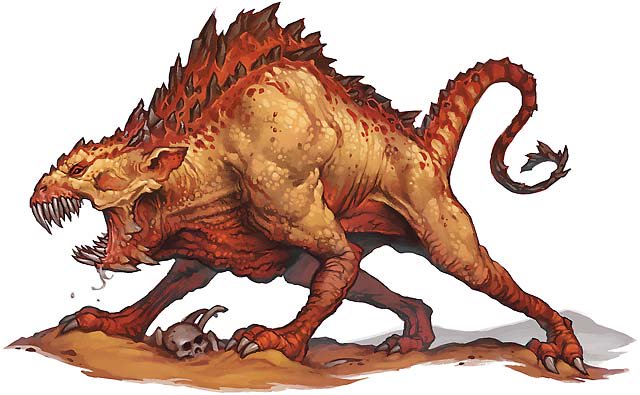Let's Read the Dark Sun Creature Catalog: Dagorran

This post is part of a series! Click here to see the rest.
The Lore
Dagorrans are carnivorous reptilian quadrupeds the size of large dogs. They can track prey by its “psychic scent”, which they can memorize either through direct contact or by stumbling into a creature’s psychic trail (i.e. through psychometry). Once a dagorran has its chosen prey’s scent, they will chase it relentlessly, across great distances, until they catch it.
In the wild, these creatures live in wide-ranging packs. Dagorran packs sleep for a handful of hours every couple of days, and spend the rest of their time on the hunt. They only stay at a single place for a while when they have to rear their young, but as soon as the pups can run with the pack they’re on the move again. Unlike some of the other magical beasts in the book, dagorran packs don’t cooperate with other predators.
Young dagorrans are sometimes captured and trained by templars, who prize them as peerless trackers and use them to track fugitives or wanted dissidents. They’re much better at this job than cilopses, who must lay eyes on the prey to start tracking and can only follow the trail for a short time.
The Numbers
Dagorrans share some similarities with baazrags (dog-like pack hunters) and with cilopses (favored templar pets), but they’re a lot more dangerous with levels in the mid-Paragon tier. They’re Natural Magical Beasts so we can consider them sapient, though I guess their thought processes are pretty alien. The creatures can understand Common, and they can communicate telepathically with other dagorrans but not with anyone else.
They have a ground speed of 8, low-light vision, and the Psychic Scent signature trait. This is a minor-action power that lets them choose a living creature or its tracks within 10 squares of the dagorran. The dagorran can ignore any level of concealment or invisibility on its chosen target, and knows the creature’s location until it either dies or the dagorran uses the power again. No wonder templars like them.
Dagorran Mindhound
These robust specimens charge in packs to surround and distract their chosen prey, opening them up for attack by their sneakier relatives (below). They’re Level 16 Brutes with 194 HP.
Their only attack is a bite that does respectable brute-tier damage, but that and Psychic Scent are enough to make them a threat.
Dagorran Ambusher
These sneaky specimens move a bit ahead of the pack and position themselves for an ambush, striking once their beefier relatives (above) begin their own part of the attack. They’re Level 17 Lurkers with 132 HP.
Ambushers deal extra psychic damage against any creature that cannot see it. This trait is somewhat confusingly named Combat Advantage. I mean, if you cannot see the ambusher you will most likely be granting it CA, but if you can see it you won’t take bonus damage even if you’re granting it CA for other reasons.
That difference will soon cease to matter, however, because their bite makes them invisble to the target for a turn on a hit. If they’re too far away to bite, they can use their standard action to Fade to Nothingness and become invisible either until they attack, or until the end of their next turn.
It’s a classical lurker setup, but the rider on their bite attack means that they can keep biting you with bonus damage for as long as they keep hitting.
Encounters and Final Impressions
Dagorran encounters are simple. A wild pack is an all-dagorran encounter. You can also find one or two of them as part of a Paragon-tier templar encounter.
Dagorrans feel a lot more “dog-like” than baazrags lore-wise, but not mechanics-wise as they lack the ability to knock people prone or any Pack Tactics style power. I think they work better as pets brought in by mixed humanoid encounter groups, since those can be more varied than a wild pack. A chase scene or skill challenge involving dagorrans is a much more drawn-out affair than one involving cilopses, as the PCs will likely have to kill or discourage the dagorrans before they can attempt to lose their pursuers.
I did find a bit surprising that they’re mid-Paragon monsters, but their stat blocks are simple enough that you could reduce their level by 10 or so and still have them work just fine as Heroic threats.